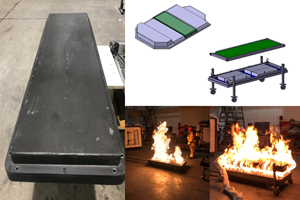Huntsman, Acciona collaborate on all-composite lighthouse
The first-ever all-composite lighthouse is now installed at the port of Valencia in Spain.
Huntsman Advanced Materials, The Woodlands, Texas, and Acciona, Madrid, Spain, worked together to create an all-composite lighthouse through a combination of new material systems and processes. Whereas concrete builds typically take 28 days to be fully cured and an additional 21 to install, the all-composite lighthouse was completed in less than 20 days – six hours of which involved its installation, using a lightweight crane due to its advantageous size-to-weight ratio.
The lighthouse project focused on short and efficient manufacturing cycle times of CFRP and GFRP composites. This was achieved using innovative materials, form factors and processing technologies. Here’s a look at how it all came together.
Developed as a first prototype by Acciona at the beginning of January 2013, this tower structure is testament to the advances in materials engineering that occurred in the short time the project took to complete in February 2015. For example, following the design and process selection, all the composite components were manufactured within a month at Acciona’s composite workshop in Madrid.
Combinations of hybrid, CFRP and GFRP composites were selected for the tower’s principal components to fulfil the design engineer’s vision for the 35m tall tower structure. To construct the tower’s structural column - made of eight 35m long CFRP pultruded tubes with an outside diameter of 250mm and 20mm thickness - Acciona developed a special pultrusion process that produced high quality, very thick pultruded profiles combining carbon tows and heavy carbon fabrics.
The epoxy-compatible glass fiber supplied by Owens Corning, Midland, Mich, for the GFRP tubes was specified for its ease of impregnation, faster pulling speed and better chemical resistance.
Architectural requirements stipulated that while the lightweight GFRP floors were subject to certain aesthetics and chemical resistance factors, they should also not exceed 20cm thickness.
Due to the constraints of cost, time, dimensional tolerance surface finish and ease of molding, Acciona decided to develop a resin infusion process to create the floors. As manufacturing needed to be fast, a resin system with low viscosity, long pot life and low exotherm, which could also meet the necessary chemical and mechanical properties, was developed by Huntsman.
The project also required the production of slip-free, light weight (<25Kg), chemically and mechanically resistant, GFRP stairs that would not exceed 20cm thickness. Composites made by resin transfer molding (RTM), using resin from Huntsman, were identified as providing the optimal solution.
To join the pultruded CFRP and GFRP tubes, and in order to achieve the low weight, low maintenance, smooth surface, chemical resistance and aesthetics required, the use of metal fasteners were ruled out and a new system was designed that could also meet the complex structural, geometric and budgetary requirements. As part of this new system, carbon and glass fiber stiffeners were designed and produced using a user-friendly and low exotherm resin developed by Huntsman.
Acciona also selected ARALDITE adhesives to bond the lighthouse’s composite components together, chosen in preference to mechanical fastenings, which would detract from the look and add unnecessary weight to the final structure.
Combining a long pot life with fast curing, and thixotropic properties that facilitated easy application on the tower’s vertical surfaces, the ARALDITE epoxy based structural adhesive specified for this project delivered significant cost and production time savings. It also added to the strength of the composite structure, contributing to its lightweight and aesthetic appeal.
Before the lighthouse was commissioned, final tests were conducted to ensure it met load and wind requirements.
The technologies developed and proven for the lighthouse project are currently under consideration in numerous other projects including towers for wind energy, columns for bridges and mobile antennas.
Related Content
Materials & Processes: Composites fibers and resins
Compared to legacy materials like steel, aluminum, iron and titanium, composites are still coming of age, and only just now are being better understood by design and manufacturing engineers. However, composites’ physical properties — combined with unbeatable light weight — make them undeniably attractive.
Read MoreJEC World 2022, Part 3: Emphasizing emerging markets, thermoplastics and carbon fiber
CW editor-in-chief Jeff Sloan identifies companies exhibiting at JEC World 2022 that are advancing both materials and technologies for the growing AAM, hydrogen, automotive and sustainability markets.
Read MorePrice, performance, protection: EV battery enclosures, Part 1
Composite technologies are growing in use as suppliers continue efforts to meet more demanding requirements for EV battery enclosures.
Read MoreAutomotive chassis components lighten up with composites
Composite and hybrid components reduce mass, increase functionality on electric and conventional passenger vehicles.
Read MoreRead Next
CW’s 2024 Top Shops survey offers new approach to benchmarking
Respondents that complete the survey by April 30, 2024, have the chance to be recognized as an honoree.
Read MoreComposites end markets: Energy (2024)
Composites are used widely in oil/gas, wind and other renewable energy applications. Despite market challenges, growth potential and innovation for composites continue.
Read MoreFrom the CW Archives: The tale of the thermoplastic cryotank
In 2006, guest columnist Bob Hartunian related the story of his efforts two decades prior, while at McDonnell Douglas, to develop a thermoplastic composite crytank for hydrogen storage. He learned a lot of lessons.
Read More










.jpg;maxWidth=300;quality=90)














